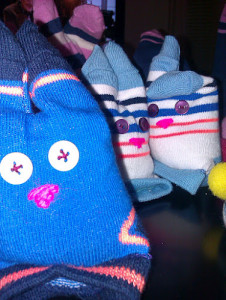Science Showoff is a monthly night which takes place in a pub in London, and features acts from all areas of science, who each have 9 minutes to perform an act – a science demo, a routine, songs, experiments – anything entertaining or fun. Having tried a little bit of the short-set, trying-to-be-funny type of science communication involved in Bright Club (a similar venture, giving researchers the chance to try stand-up comedy, which started in London and has now spread all over the country), I thought it would be good to give it another go – in fact, Science Showoff was recommended to me by someone who saw my Bright Club set in Manchester. I had prepared an 8-minute piece about Fibonacci numbers to perform in Manchester, inspired by my artist friend’s admission that she didn’t see how maths could be interesting in the same way as art; she wasn’t there to watch, but I went down well (and ran horribly over time). So I decided to reprise my set at Science Showoff in February 2012 – and this time it would be the right length, and would be new and improved with all the best jokes left in and the duds taken out.

Mathematicians are already at a disadvantage when it comes to demo competitions and stage sets, since other subjects have lots of nice explosions, noises, flashing lights and cool materials which you can see and touch. Maths has equally many beautiful things, but they’re not always as obvious. I decided to go straight in and give them an exciting maths demo – using bunnies. I decided that using Fibonacci’s explanation of how the Fibonacci numbers can be found in the population size of mating rabbits was nice and neat, and of course, sex sells. I hand-crafted a set of sock bunnies (filled with rice, buttons for eyes) which I drew from a hat in pairs, illustrating how at each stage of development, some of the pairs of rabbits are old enough to mate and others are still juvenile, and so the population grows with the size of the generations before last. Of course, these rabbits aren’t really an accurate model – they all mate every season, producing exactly one pair of offspring, which later mate with each other; and they never die. These incestuous immortal creatures went down a storm with the crowd, especially as my placing of rabbits in pairs on the front of the table degenerated in time to dumping handfuls of floppy rabbits onto an increasing pile of bunnies, spilling off the front of the table and prompting a round of applause when I ran out of rabbits and couldn’t go any further.
\[ \Phi = \frac{1}{1+\frac{1}{1+\frac{1}{1+\frac{1}{1+\dots}}}} \]
The continued fraction representation of the Golden Ratio $\Phi$.
I continued by defining the Golden Ratio, and showing some of the many equations which give the Golden Ratio – continued fractions, nested radicals, simple surds and horrible summations. The beauty to me of this number is the number of different ways you can define it, and all of them seem somehow really nice – the continued fraction is an endless repetition of ones, which is surely the nicest continued fraction? Golden Ratios crop up in a pentagram, line segments and rectangles with nice properties.
Having run through these, using my printed A3 slides (‘paper point’), I finished by demonstrating a nice occurrence of the Golden Ratio in nature; in the last 30 seconds of my set, I grabbed a volunteer from the audience who knew her exact height. Dividing by the Golden Ratio, and then measuring the resulting distance from the floor, gave the (well, almost exact) height of her navel. The crowd went wild! And I only overran by a few seconds.
Other acts on the night included a recipe for making concrete, a forensic scientist using X-rays to identify tattoos which had been lasered off or tattooed over, and some wonderful musicians, with Professor Karmadillo singing a song about Green Fluorescent Protein and its uses in identifying gene expression, and the lovely Helen Arney who got us all to sing a googol. The highlight of the evening was everyone being given glowsticks and drawing the symbols of chemical elements in the air, captured using a long-exposure camera which resulted in a much more exciting version of the periodic table.
My Science Showoff experience was good, but I imagine that’s down to my set going well and not ending in disaster, as well as the lovely things people said about my set and the welcoming environment provided by the organisers. If you’re interested in trying out something new, then I can recommend it as an outlet for (9 minutes’ worth of) performance. But remember – if you’re going to talk about maths, you need to have something really exciting to say, or else you’ll be forgotten among the glowsticks and explosions.